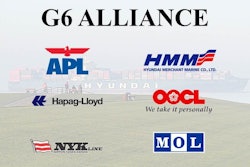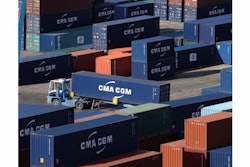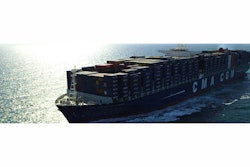Late last week the U.S. Federal Maritime Commission unanimously voted to allow the G6 Alliance to expand into the Asia-U.S. West Coat and trans-Atlantic routes.
U.S. approval will allow the carriers — APL, Hapag-Lloyd, Hyundai Merchant Marine, MOL, NYK and OOCL — to better compete with the massive vessel-sharing agreement sought by the three largest global container lines. The FMC last month approved the P3 Network of Maersk Line, Mediterranean Shipping Co and CMA CGM, but Chinese authorities have yet to signal whether they will give the massive VSA their blessing.
Although the P3 doesn’t require regulatory approval in European Union, regulators can end the VSA if they find it breaks antitrust rules.
“The commission’s action on the G6 Alliance is based on an extensive, competitive analysis conducted by the commission’s staff and comments received by shippers and other industry participants,” FMC Chairman Mario Cordero said in a statement. “The commission will continue to review the competitive impact of global alliances.”
The FMC said the G6 expansion is not likely to produce an unreasonable increase in transportation cost, nor will it likely cause an unreasonable decrease in service. Both measures set forth by the Shipping Act of 1984 are how commissioners determine whether to allow a VSA or seek an injunction against one via federal court. The commission will require a modified monitoring program for the new G6 VSA.
According to the agreement, the G6 carriers can create and maintain one or more service centers, where the lines can perform day-to-day management. The carriers can also use the center(s) to coordinate administrative and service functions, such as vessel scheduling and allocating slots among themselves. The carriers will also be able to jointly forecast demand, communicate with providers and suppliers of vessel-related goods and services, monitor bunker usage and perform other tasks. The G6 Alliance’s move to create one or more service centers will bring their VSA closer to the model of the P3, which plans to operate it own network center headed by Maersk executive Lars Mikael Jensen.
The G6 Alliance aims to deploy 240 container ships serving 66 ports in Asia, the Americas and Europe. The G6 lines, which currently cooperate on the Asia-Europe and Asia-U.S. East Coast routes, will operate 76 vessels covering 12 services connecting 27 ports in Asia and on the West Coast of the United States. A further 42 ships will operate five trans-Atlantic services, including two pendulum services, calling at 25 ports in the U.S., Canada, Panama, Mexico, the Netherlands, the U.K., France, Belgium and Germany.
Each G6 carrier will be able to offer almost twice as many sailings on the Asia-North America trade as what it currently operates separately, the alliance said in a news release.
The six container lines that make up the G6 accounted for 27.1 percent of U.S. containerized export trade and 28.6 percent of U.S. containerized import trade in the first nine months of 2013, according to information compiled from PIERS, the data division of JOC Group Inc. Not all services offered by these lines will be included in the G6 expansion; Hapag-Lloyd, for example, has noted that it will continue to offer its ATA services and Mediterranean services outside of the G6
In comparison, the P3 would represent roughly 42 percent of Asia-Europe capacity, 24 percent of trans-Pacific capacity and 40 to 42 percent of capacity on the trans-Atlantic, according to the FMC.
To read more, click HERE.



















